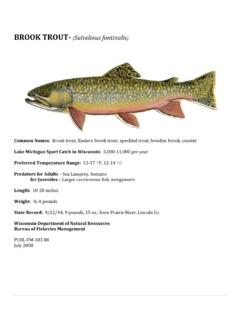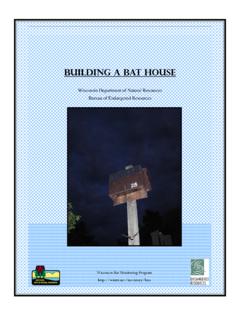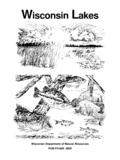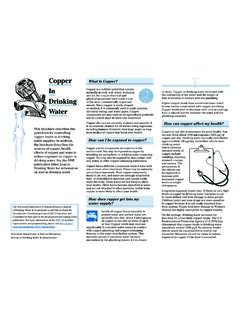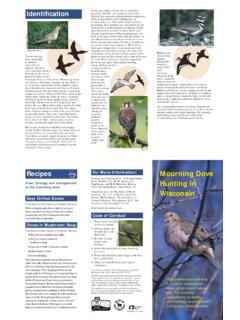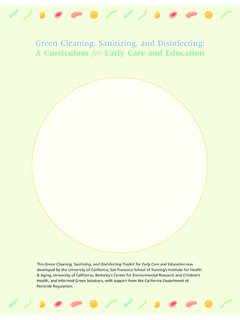Transcription of Step-By-Step Guide to Raising Oak Trees from Seed
1 Step-By-Step Guide to Raising Oak Trees from seed A nature-oriented classroom or take-home activity that everyone can enjoy. Throughout Wisconsin's history, oak Trees have provided shelter, enjoyment and food to humans and wildlife species. Growing oak Trees from seed is a practical and fun way to learn about seedling germination and the life cycle of a tree . Oaks, either from the white oak or the red oak group, grow readily and relatively quickly from acorns. Though you could plant acorns outside in the fall and let nature take its course, there is a risk that they'll dry out, freeze, rot or be lost to foraging rodents. Planting them in pots is a more reliable approach. The steps described here also work for other nut Trees , such as hickory and walnut.
2 The genus Quercus, to which all oaks belong, contains two major groups in North America: the 2. Stratify and store. white oaks and the red oaks. Acorns in the white The two most oak group take one year to mature, while red oak crucial components acorns mature in two years. Species in the white in caring for acorns is not allowing them to dry oak group include bur, chinkapin, swamp white out and not allowing them to heat up. Many, but and white oaks. Species in the red oak group not all, oaks require cold treatment. For instance, include black, northern pin and red oaks. A field red oak acorns need a period of cold to stimulate Guide will help you identify individual Trees . germination, while white oak acorns can be planted immediately or refrigerated for later planting.
3 1. Collect acorns. Fulfilling their need for a cool, moist period is easy The best way to do indoors through a process called stratification. to obtain To stratify, place a handful of acorns in a plastic good-quality acorns is to collect them in mid-fall bag. Add an equal volume of moist, well-drained from healthy, vigorous Trees . You will know when sand, a sand-moss mixture or sawdust. Seal acorns are ready to be harvested when they begin the bag loosely, label it with the species and falling from the tree . Gather acorns from tree date, and store it in a refrigerator set at 40 F. branches or the ground. Lawns or paved areas make Check acorns periodically to make sure they great collection sites because acorns are easy to spot are just barely damp.
4 After 30 to 90 days have and harvest. Be sure to identify the Trees you collect passed, an embryonic root, called a radicle, will from so you know what species you are growing. emerge from the seeds. Once several acorns To determine if an acorn is ripe, simply wiggle the have sprouted, prepare to plant all of them. cap. If the two separate easily, the acorn is ready. Then inspect your harvest more closely. Healthy acorns look plump and feel relatively heavy for their size. Discard any that are cracked, moldy, hollow, feel light in weight or have small holes. 40 . A good way to identify discards is to place the 20. acorns in a bucket of water those that float are empty and will not produce a seedling.
5 Because 0. acorns lose viability quickly if they dry out, it's a -20. good idea to proceed to the next step right away. Brought to you by the Wisconsin Department of Natural Resources - Division of Forestry 3. Plant the acorns. Due to the very 5. Enrichment. Students can use acorns (as well long taproot produced by oaks, a deep as a variety of other tree seeds) to learn skills container (more than 8 inches deep) is such as comparisons, measurements of size and best for planting. Make sure the pots weight, and observations of color, texture and have drainage holes at the bottom. Milk smell. They may enjoy Raising oak seedlings One option for a homemade pot is to to plant at home, or to sell and raise funds use a cardboard one-quart milk carton for outdoor school forest supplies, classroom with -inch holes cut into the base.
6 Activities or community service projects. Wash pots well and fill them to within an inch Helpful websites of the top with moistened Dichotomous tree Identification Key for Students: Milk commercial potting mix or a mix of equal parts loam, sand and peat. The potting soil sold at most nurseries is excellent. Place the acorns about an inch below the surface, deeper if Determine when to plant by looking at the typical the acorn is particularly large. Plant dates of the last spring frost in your area: one seed in each container and cover with -inch of potting mix. 4. Care. Water the pots immediately after Proper tree Planting: planting, and thereafter whenever the top inch or two of soil is dry.
7 Keep the soil moist but aerated. Oak seedlings can grow well outside in partial shade, however, for indoor Milk growth, full sun is needed. Wherever they are stored, seedlings should be protected from freezing weather, drying winds and curious rodents. Don't allow an oak seedling's taproot to grow out of the bottom of the M a r. - A p ri l container, as this will break the root. If seedlings are grown indoors, place them outside, in a protected area, after the last spring frost so they can become acclimated to the elements. If possible, seedlings should be transplanted as soon as the first leaves open and before extensive root development occurs. Outdoor planting should be done in March, April or May (based on your location in Wisconsin) so seedlings have time to establish themselves before the heat of summer.
8 Even if seedlings will remain in pots for a year, they should be placed outside from spring through fall. Exposure to full sun and wind will produce stronger, hardier growth. When transplanting your oak seedlings, the planting hole should be twice as wide and deep as the pot and roots. Carefully remove the roots and set in the hole with the root collar (the place where the stem meets the root system) at ground level. Fill the hole with soil, firmly tamp and water thoroughly. Brought to you by the Wisconsin Department of Natural Resources - Division of Forestry
